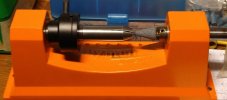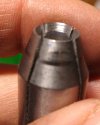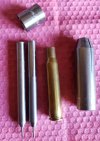Spindrift
Well-Known Member
Like probably many of you, I like and use the Lee collet die for neck- sizing my rifle brass. It is an affordable, effective tool that creates good cartridges. After sizing the necks, I expand and flare the necks using the appropriate expander plug.
Lee offer many spare die- parts, and sometimes these can be combined to change the functionality of the tool. I wanted to modify a 30-06 LCD, so it set neck tension to 0,0015in with .310 bullets, and left the case mouth unsized/flared.
Regarding neck tension, you can adjust this by the position of the die. But this would not be a «set and forget» adjustment, as another brand of brass would be different. Better then, to have a mandrel of the appropriate size. Lee offer a mandrel for the .303 Brit, which is the same length as the .30-06 (or .308) mandrel. The original .30-06 mandrel was .3057, the .303 Brit was (forgot to write it down!) about .3075.
I did some measuring and calculations, and found out my die with the original mandrel gave an internal diameter exactly 0,002in larger than the mandrel. Since I wanted an internal diameter of .3085 after sizing, I honed the .303 Brit- mandrel to .3065. Easily done, by chucking the mandrel in a cordless drill.
The hole in the sleeve also needed to be enlarged a little, easily achieved with a drill, brass brush with some steel wool and grinding compound. There should be some play between mandrel and sleeve, to allow for dynamic alignment.
In order to get the auto- flare function, some material must be removed from the collet fingers, so the case mouth remains untouched. I used a conical grinding tool designed for Dremel- type grinders. With a little tape on the shaft, it was a snug and centered fit in the trim-guide hole of a case trimmer. I used a fird, unsized, decapped sacrificial 30-06 case for «collet holder», to keep the collet reasonably centered and level.

Grinding this by hand was time- consuming, but very controlled. And the result seems to be quite good. And in the long run, this should save me quite a few pulls of the handle, as I shoot a lot of 30-06 cast bullet loads.

Edit:
PS the "auto- flare" function is not my idea! I learnt it from Ian!
Lee offer many spare die- parts, and sometimes these can be combined to change the functionality of the tool. I wanted to modify a 30-06 LCD, so it set neck tension to 0,0015in with .310 bullets, and left the case mouth unsized/flared.
Regarding neck tension, you can adjust this by the position of the die. But this would not be a «set and forget» adjustment, as another brand of brass would be different. Better then, to have a mandrel of the appropriate size. Lee offer a mandrel for the .303 Brit, which is the same length as the .30-06 (or .308) mandrel. The original .30-06 mandrel was .3057, the .303 Brit was (forgot to write it down!) about .3075.
I did some measuring and calculations, and found out my die with the original mandrel gave an internal diameter exactly 0,002in larger than the mandrel. Since I wanted an internal diameter of .3085 after sizing, I honed the .303 Brit- mandrel to .3065. Easily done, by chucking the mandrel in a cordless drill.
The hole in the sleeve also needed to be enlarged a little, easily achieved with a drill, brass brush with some steel wool and grinding compound. There should be some play between mandrel and sleeve, to allow for dynamic alignment.
In order to get the auto- flare function, some material must be removed from the collet fingers, so the case mouth remains untouched. I used a conical grinding tool designed for Dremel- type grinders. With a little tape on the shaft, it was a snug and centered fit in the trim-guide hole of a case trimmer. I used a fird, unsized, decapped sacrificial 30-06 case for «collet holder», to keep the collet reasonably centered and level.

Grinding this by hand was time- consuming, but very controlled. And the result seems to be quite good. And in the long run, this should save me quite a few pulls of the handle, as I shoot a lot of 30-06 cast bullet loads.

Edit:
PS the "auto- flare" function is not my idea! I learnt it from Ian!
Last edited:

